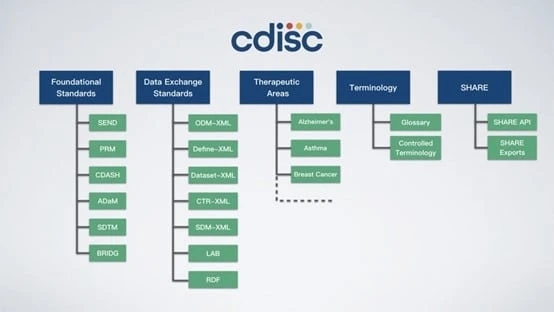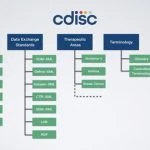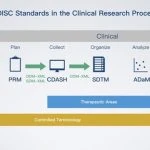1. What is CDISC
The full name of CDISC is Clinical Data Interchange Standards Consortium, which is the Clinical Data Interchange Standards Association. It is a non-profit organization. Committed to providing data standards for the development of medical and biopharmaceutical products.
What we usually call CDISC refers to the data standard developed by this association, that is, the CDISC standard. These standards are used for the acquisition, exchange, submission and archiving of clinical and non-clinical data.
2. Why adopt the CDISC standard?
The CDISC official website lists the following benefits of implementing CIDSC standards:
- Improve efficiency
- Complete traceability
- Enhance innovation
- Improve data quality
- Promote data sharing
- Reduce costs
- Improve predictability
- Simplify the process
Let’s take a practical application scenario.
With the popularization of artificial intelligence technology, we have found that the threshold for technology application is gradually lowering, but the large enough data required to apply technology is difficult to solve in the short term.
First of all, a large amount of medical data exists in different systems and research. Due to the adoption of non-standard or standards in a certain field, these data are like information islands, which are difficult to connect and share. Secondly, within these information islands, due to the lack of unified "construction" standards, if you want to reuse it, you must know the internal "construction" details. If you want to reuse thousands of research data, the workload will undoubtedly be very large. huge.
The two problems faced above are exactly what the CDISC standard can solve.
First, develop unified data standards for the construction of data structures. Whether for humans or machines, the readability and reusability of data are greatly improved. Second, develop data exchange standards for different systems. Data exchange improves data integrity.
3. Composition of CDISC standards
The CDISC standard is constantly evolving. According to the current structure of the CDISC official website, the CDISC standard can be summarized into the following five parts:
CDISC family portrait
- Foundational Standards
The basic standard is the core of the entire CDISC standard. Defines the model, domain and specification of data representation (Data Rrepresentation).
CDISC standards in the clinical research process
The basic standard consists of the following parts:
It is the implementation standard for SDTM for non-clinical studies. SEND specifies methods for collecting and presenting non-clinical data in a consistent format.
- Protocol Representation Model PRM (Protocol Representation Model)
Provide standards for the design of research protocols.
- Clinical Data Acquisition Standards Harmonization (CDASH)
Content standards for data collection fields in case report forms. For example, the theme EDC system of our series should build a database in accordance with the standards of CDASH and SDTM.
- Study Data Tabulation Model SDTM (Study Data Tabulation Model)
The so-called tabulation, in layman\'s terms, is a standard for data organization and formatting. The purpose of CDISC developing SDTM is to submit unified standard data to regulatory agencies and improve review efficiency.
- Analysis Data Model ADaM (Analysis Data Model)
Establishes standards to be followed when creating analysis data sets.
- BRIDG
BRIDG is a domain analysis model. The main role of BRIDG is to exchange information between medical information systems (such as HIS, LIS, and PACS) that comply with HL7 standards and clinical research systems that comply with CDISC standards. BRIDG is simultaneously a CDISC, HL7 and ISO standard.
- Data Exchange Standards
As the name suggests, the role of data exchange standards is to exchange, share, submit and archive structured data between different systems. Data exchange standards are vendor-neutral and platform-independent. The XML mark means that the standard file format is XML (Extensible Markup Language).
Data exchange standards consist of the following standards:
- ODM-XML
XML-based Schema defines content and format standards for obtaining, exchanging, submitting and archiving clinical research data in accordance with regulatory requirements. A common infrastructure is provided for Define-XML, Dataset-XML, SDM-XML and CTR-XML, and they all extend ODM-XML.
- Define-XML
ODM-based metadata standard used to describe metadata for SEND, SDTM and ADaM in order to inform regulatory authorities which data sets, variables, controlled terms and other specific metadata are used.
- Dataset-XML
Dataset-XML is used to describe SEND, SDTM and ADaM data sets. CDISC developed Dataset-XML with the purpose of replacing SAS V5 XPORT. Why replace it? Because it is a format standard unique to commercial companies. Dataset-XML makes some improvements over SAS V5 XPORT, removing many SAS V5 transfer file limitations (the current file format required by the FDA and PMDA), such as 8-character variable names and 200-character text field lengths. Dataset-XML and Define-XML are complementary standards, and Define-XML metadata describes the contents of the Dataset-XML data set.
- CTR-XML (Clinical Trial Registry XML)
Promotes standards for the submission of clinical trial information to global clinical trial registries. Examples include the World Health Organization (WHO), the European Medicines Agency (EMA) and ClinicalTrials.gov.
- SDM-XML(Study/Trial Design Model XML)
The Study/Trial Design Model is an extension of ODM that defines a machine-readable, interchangeable standard for describing clinical study design.
- LAB
The LAB standard is specifically designed for the exchange of laboratory data obtained in clinical trials. Provides a standard model for the acquisition and exchange of laboratory data.
- RDF (Resource Description Framework)
The full name of RDF is Resource Description Framework. It is a set of markup language technical specifications proposed by W3C, which is used to describe and express the content and structure of network resources. CDISC\'s RDF defines the basic standards of CDISC and is expressed in the Resource Description Framework (RDF).
3. Therapeutic Areas
It is an extension of the basic standard and develops data standards related to specific disease areas. At present, standards for more than 30 specific disease areas including Alzheimer\'s disease, Ebola, Parkinson\'s disease, asthma, etc. have been released.
4. Terminology
In brief, the Glossary explains the definitions and terminology related to the collection, exchange, and submission of data during non-clinical and clinical research phases. Contains all terms involved in the CDISC standard.
5. CDISC SHARE
The full name of SHARE is Shared Health And Research Electronic library, which is a set of tools and services. When we create databases and applications for CIDSC standards, classes, fields, and variables are manually extracted from PDFs, and SHARE facilitates the automation of standards by providing variables and other CDISC standard metadata in a machine-readable format. management and implementation.
- Regulatory agencies and CDISC standards
Currently, FDA submissions require the following CDISC standards:
- Controlled Terminology
- SEND
- SDTM
- ADaM
- Define-XML
Documents submitted by PMDA require the following CDISC standards:
- SDTM
- ADaM
- Define-XML
- Analysis Results Metadata (ARM for Define-XML)
Currently, SFDA does not require submitted documents to comply with CDISC standards.
“In order to improve the quality of clinical trial data and the quality and efficiency of statistical analysis, and facilitate the exchange and summary analysis of data, when applying for new drug marketing registration, it is recommended to submit the original database and analysis database using CDISC standards.” - "Clinical Trial Data Management Work" Technical Guide
References
- CDISC official website. https://www.cdisc.org
2.CDISC WIKI. https://en.wikipedia.org/wiki/Clinical_Data_Interchange_Standards_Consortium
3.Sam Hume.CDISC Standards Beginning to End (B2E),21-Feb-2017
4.Wayne R. Kubick.CDISC SHARE: A BRIDG-based Metadata Repository Environment
5.Giri Balasubramanian,Edwin Ponraj Thangarajan.CDISC Transport Standards - A Glance.Digital Innovation in Healthcare,8th-11th Oct 2017.
- Wu Chongsheng, Bao Wenjun, Wang Jun, Peng Ruiling, Deng Yazhong, Zhang Zibao. Introduction to CDISC standards and their application in China [J]. Acta Pharmaceutical Sinica, 2015, 50(11): 1428-1433.
7.Samuel Hume, Anthony Chow, Julie Evans, Frederik Malfait, Julie Chason, J. Darcy Wold, Wayne Kubick, Lauren B. Becnel.CDISC SHARE, a Global, Cloud-based Resource of Machine-Readable CDISC Standards for Clinical and Translational Research.
- Wen Tiancai, He Liyun, Liu Baoyan. BRIDG model: a bridge for the exchange of medical information and clinical research information. China Digital Medicine, 2010, 5(8):0-0.





